Surya Namaskar, also known as Sun Salutation, means bowing down to the sun. Surya Namaskar is a composition of 12 powerful yoga poses in a sequence. It is among the favourite sequenced asanas of many yogis. They do this as a warm-up as it energises the body and eases out the stiffness, but it is a complete workout in itself when done intensely. It has a profound effect on the body and mind as it is a combination of postures, breaths and mantras.
The best time to perform Surya Namaskar is early in the morning on an empty stomach. It tones and stretches the muscles, massages the inner organs, and helps to relieve constipation, speeds up the metabolism and helps to reduce weight.
So even spending 15 minutes of your day practising Sun Salutations can be used to calm the mind, and promote health and balance.
Why 108 Surya Namaskars?
We all have heard about the tradition of practising 108 sun salutations in a row. In the beginning, it may sound very difficult but with the right routine, it is absolutely achievable. It’s actually an ancient tradition with a deeply spiritual meaning and innumerable health benefits.
This practice is linked to the ‘108’ which is considered a sacred number. There are 108 Upanishads and 108 Tantras. In numerology, 108 equals 9, which symbolises universal love, eternity and awakening. In Ayurveda, there are 108 sacred points on the body. Mala bead necklaces have 108 beads, which are used to count during meditation.
The internal heat that you build during this practice helps in cleansing and detoxifying. It helps your body activate prana, the upward energy. It makes you physically strong and helps in positive energy flow.
Basic Guidelines To Start Practicing 108 Surya Namaskars
- Start with a few sets initially, and increase gradually. For example, if you are already used to doing 4 sets of Surya Namaskar, then start with 6 sets and everyday increase 2-3 sets
- Once you reach a big number like 20-22 sets, you may want to continue practising it for a week and then start increasing the sets again on a daily basis
- Plan your day-offs. Do not stress yourself to finish the number of sets you might have targeted. Listen to your body and pause whenever you feel like
- Keep yourself well hydrated
- After your daily practice of Surya Namaskar ensure you are relaxing properly
- Consider practising yoga Nidra
Each step of the sequence in Surya Namaskar is associated with twelve names of the God Surya, the sun.
Surya Namaskar: A Step-By-Step Guide With Benefits
Step 1: Pranamasana (Prayer Pose)
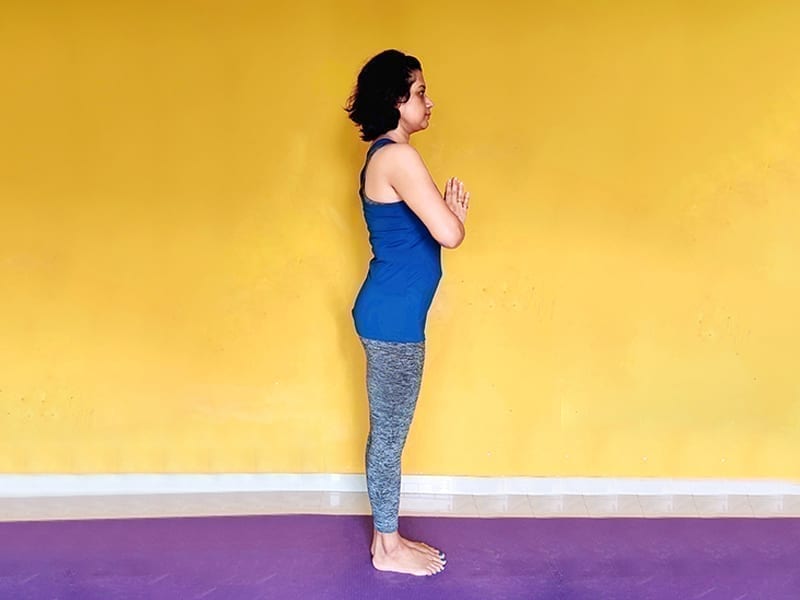
ॐ मित्राय नमः Oṃ Mitrāya Namaḥ (affectionate to all)
- Stand upright and keep your feet together.
- Balance your weight equally on both the feet.
- Expand your chest and relax your shoulders.
- Bring the palms to meet in the centre of your chest.
- Relax the whole body and breath normally.
Benefits:
- Improves posture
- It helps maintain the balance of the body
- Relaxes the nervous system
- Brings awareness
Step 2: Urdhva Hastasana (Raised Arms Pose)
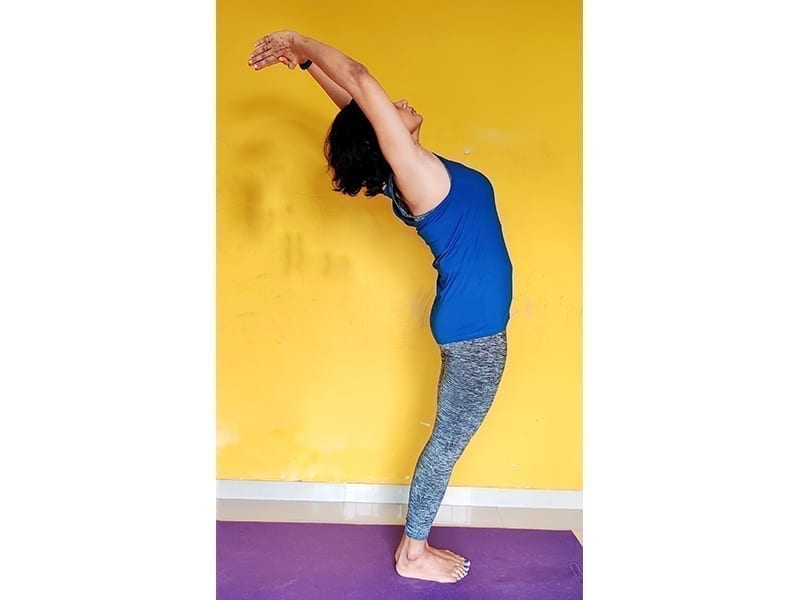
ॐ रवये नमः Oṃ Ravaye Namaḥ (cause of all changes)
- Breath in while gently lifting your arms in the backward direction, keeping the arms close to the ears.
- Give a good stretch to your whole body.
Benefits:
- Improves digestion as it stretches the abdominal muscles
- Chest expansion helps in clearing the passage for breathing from the diaphragm. This, in turn, cures asthma and heavy breathing
- It is a good stretch for shoulders and armpits
- Helps relieve mild anxiety
Step 3: Padahastasana (Hand To Foot Pose)
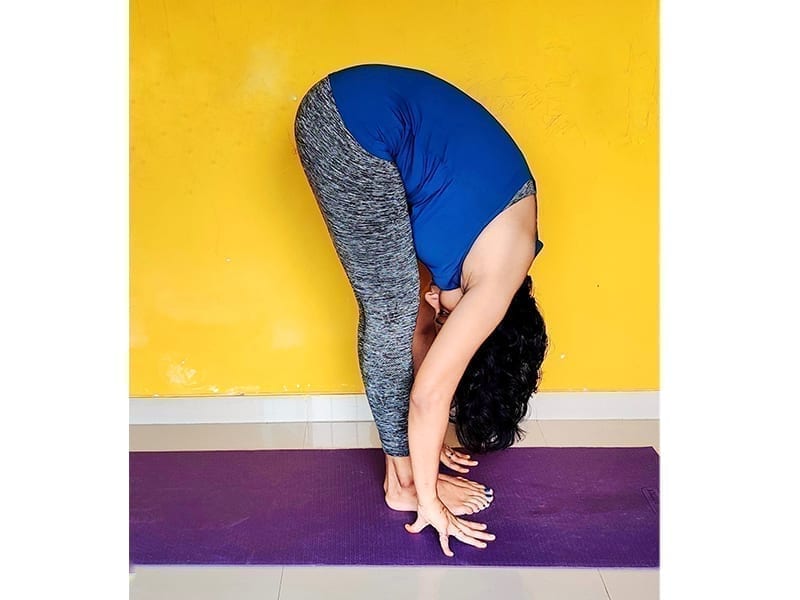
ॐ सूर्याय नमः Oṃ Sūryāya Namaḥ (who is the dispeller of darkness and responsible for bringing activity)
- While exhaling, bend forward from the waist, keeping the spine straight.
- Try to touch your feet and head to the knee or just bend till whatever extent you can and keep your knees locked.
Benefits:
- Hasta Padasana makes the waist and spine flexible
- Stretches the hamstrings
- Opens the hips, shoulders, and arms
Step 4: Ashwa Sanchalanasana (Equestrian Pose)
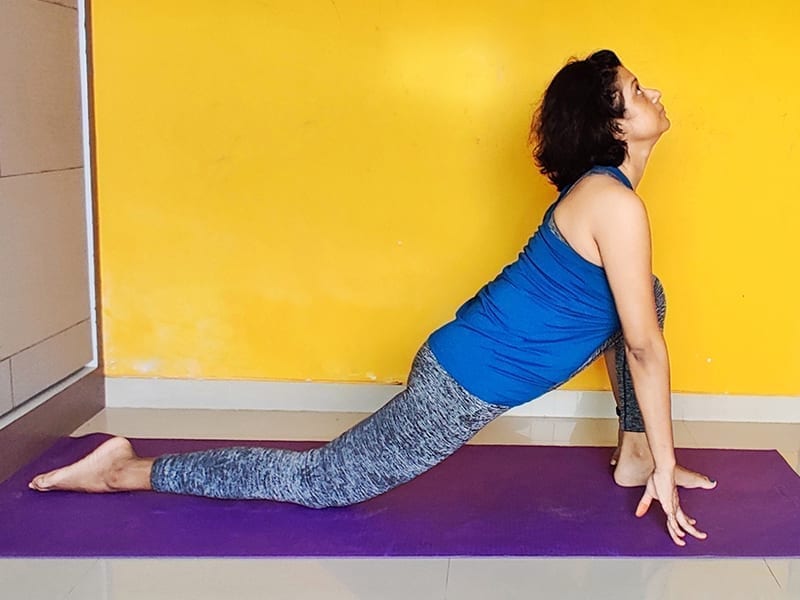
ॐ भानवे नमः Oṃ Bhānave Namaḥ (who diffuses light)
- Breathing in, push your right leg back, as far back as possible.
- Bring the right knee to the floor and look up.
Benefits:
- Ashwa Sanchalanasana strengthens the leg muscles
- It makes the spine and neck flexible
- Good for indigestion, constipation, and sciatica
Step 5: Adho Mukha Svanasana (Mountain Pose)
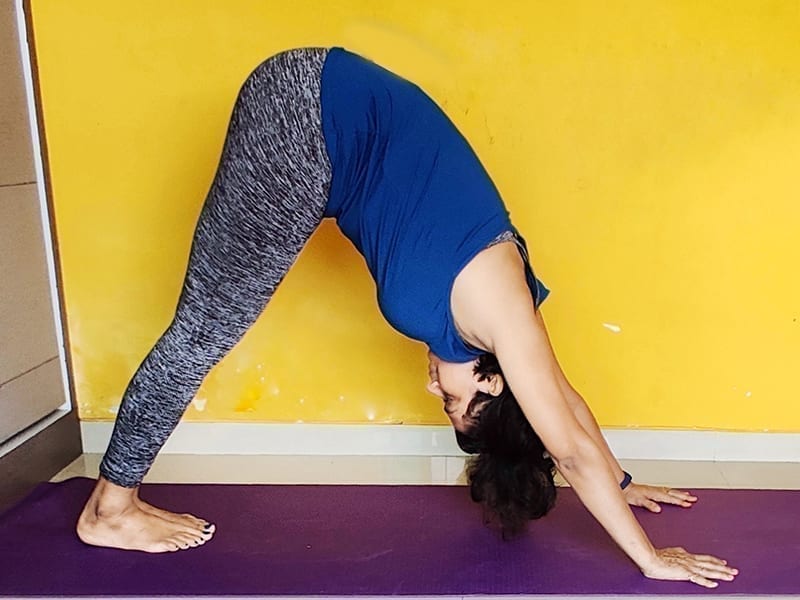
ॐ खगाय नमः Oṃ Khagāya Namaḥ (who moves in the sky)
- With exhalation lift your knees off the floor.
- Lift the hips and the tail bone up, chest downwards.
- The body should look like an ‘inverted V’ shape.
- Try to touch your heels on the floor and make a gentle effort to push your hip up, going deeper into the stretch.
Benefits:
- Relieves stress and helps in soothing the brain
- It’s a good stretch for the shoulders, hamstrings, calve muscles and hands
- Strengthens the arms and legs
- Helps relieve the symptoms of menopause and menstrual disorders
Step 6: Ashtanga Namaskara (Saluting With Eight Points Or Parts)
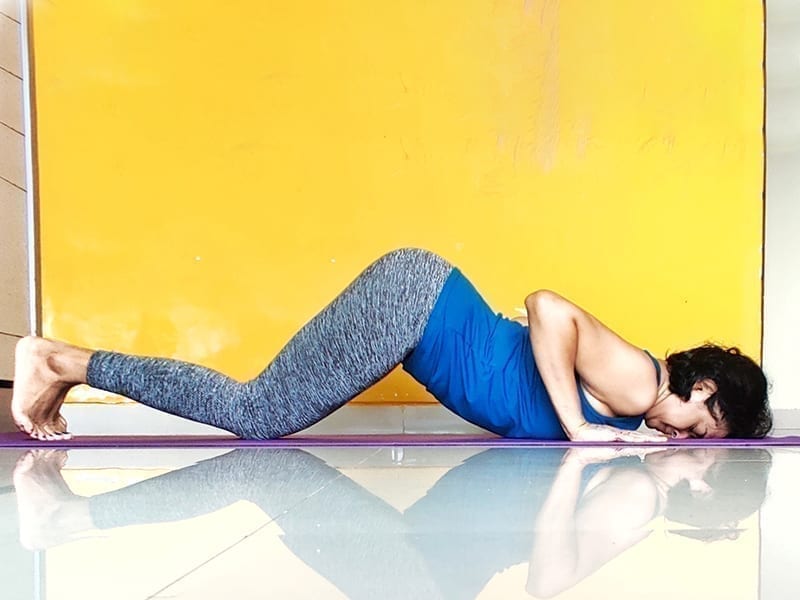
ॐ पूष्णे नमः Oṃ Pūṣṇe Namaḥ (who nourishes all)
- Now with exhalation bring both the knees down on the floor.
- Bring your chest and chin on the floor. The abdomen should be off the floor.
- Raise your posterior a little bit.
- Both the palms, feet, two knees, chest and chin should touch the floor.
- Ashtanga Namaskara is also called Ashtanga Dandavat Pranam and Eight Limbed Pose.
Benefits:
- It strengthens the muscles of the hands and legs
- It strengthens the chest
- Enhances the flexibility of the back and spine
- Provides strength to the back muscles
Step 7: Bhujangasana (Cobra Pose)
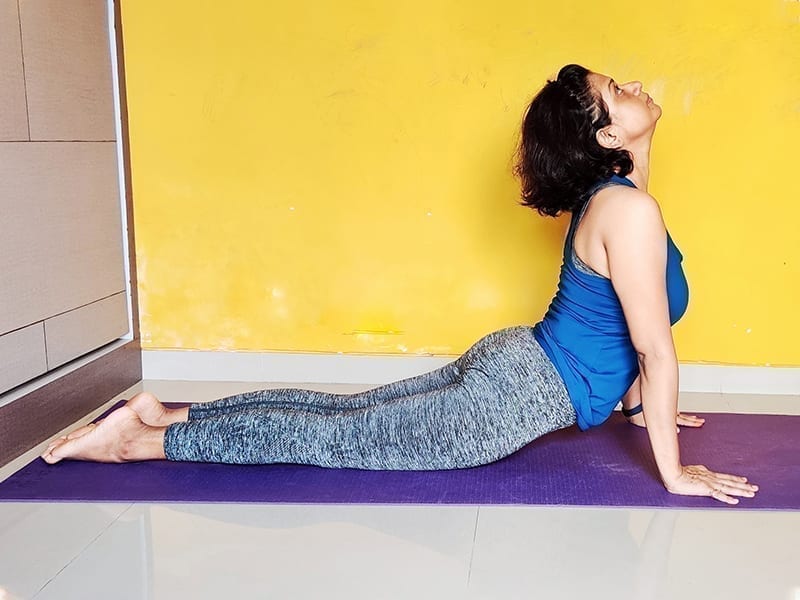
ॐ हिरण्यगर्भाय नमः Oṃ Hiraṇya Garbhāya Namaḥ (who has golden coloured brilliance)
- With an inhalation, slide your body forward and raise the chest up into the Bhujangasana.
- Look up and open up your chest.
Benefits:
- Strengthens the spine
- Stretches chest and lungs, shoulders, and abdomen
- Stimulates abdominal organs
- Helps relieve stress and fatigue
- Opens the heart and lungs
Step 8: Adho Mukha Svanasana (Mountain Pose)
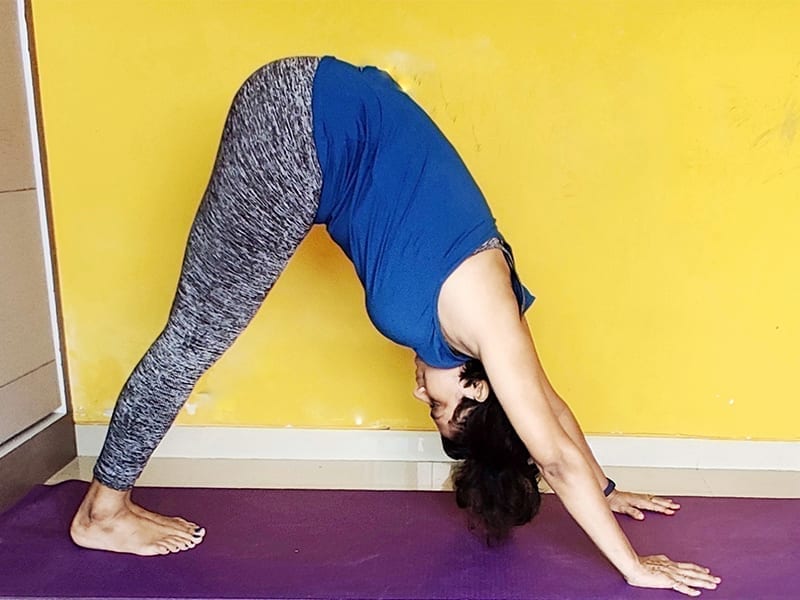
ॐ मरीचये नमः Oṃ Marīcaye Namaḥ (the giver of light with an infinite number of rays)
- With an exhalation, lift your knees off the floor.
- Come back to Adho Mukha Svanasana.
- Lift the hips and the tail bone up, chest downwards.
- The body should look like an ‘inverted V’ (/\) shape.
- Try to touch your heels on the floor and make a gentle effort to push your hip up, going deeper into the stretch.
Benefits:
- Relieves stress and helps in soothing the brain
- It’s a good stretch for the shoulders, hamstrings, calve muscles and hands
- Strengthens the arms and legs
- Helps relieve the symptoms of menopause and menstrual disorders
Step 9: Ashwa Sanchalanasana (Equestrian Pose)
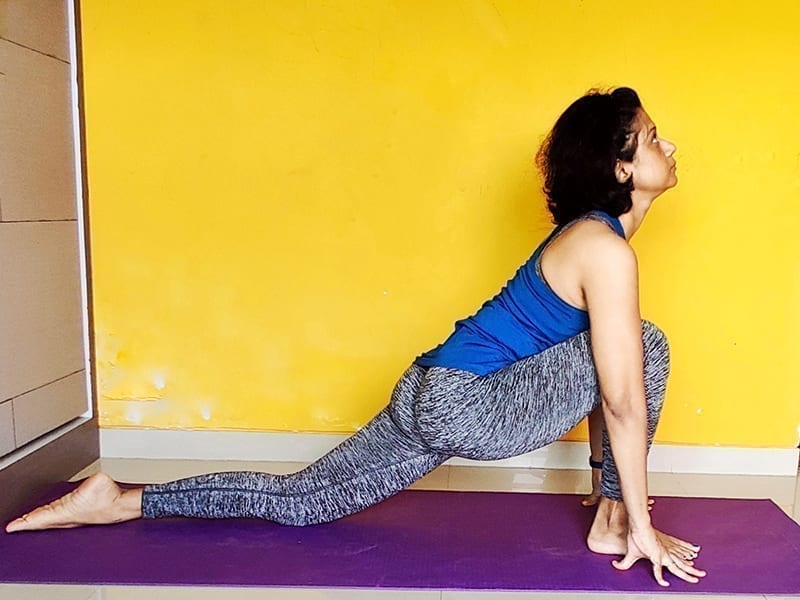
ॐ आदित्याय नमः Oṃ Ādityāya Namaḥ (the son of Aditi, the cosmic divine mother)
- With an inhalation, bring your right leg in front, between your palms.
- Place your left knee on the flow and look up.
Benefits:
- Ashwa Sanchalanasana strengthens the leg muscles
- It makes the spine and neck flexible
- Good for indigestion, constipation, and sciatica
Step 10: Padahastasana (Hand To Foot Pose)
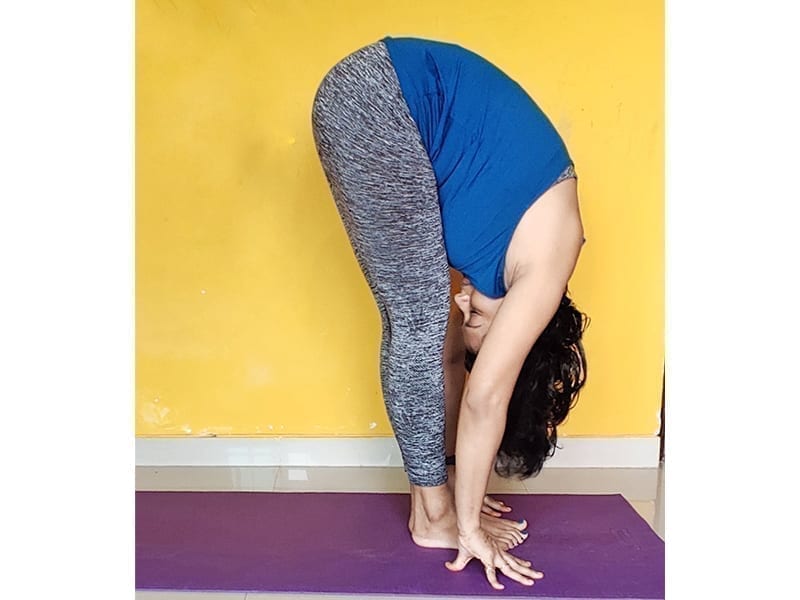
ॐ सवित्रे नमः Oṃ Savitre Namaḥ (one who is responsible for life)
- With an exhalation, now bring your left leg forward between your palms.
- Maintain the forward bend posture.
- Try to touch your feet and head to the knee or just bend till whatever extent you can and keep your knees locked.
Benefits:
- Hasta Padasana makes the waist and spine flexible
- Stretches the hamstrings
- Opens the hips, shoulders, and arms
Step 11: Urdhva Hastasana (Raised Arms Pose)
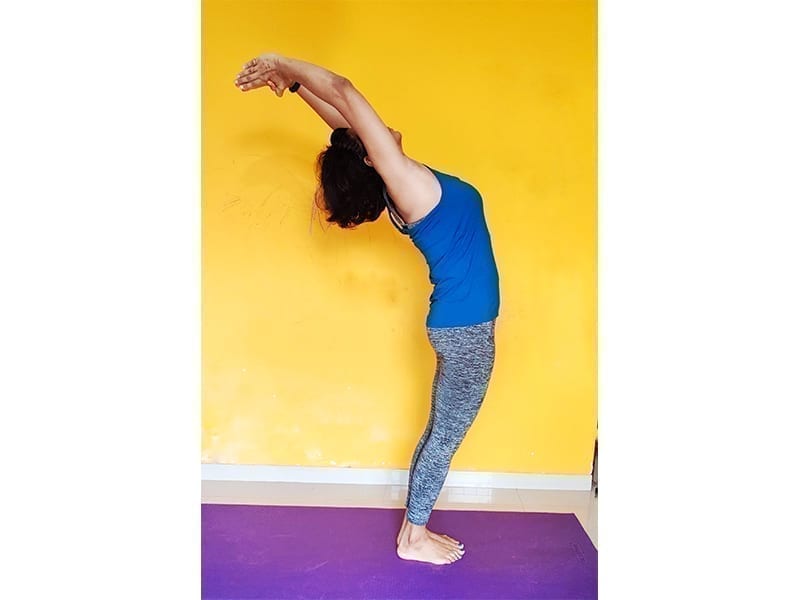
ॐ अर्काय नमः Oṃ Arkāya Namaḥ (worthy of praise and glory)
- Now, keeping your back straight, breath in and lift your body up.
- Gently arch your back along with lifting your arms in the backward direction, keeping the arms close to the ears.
Benefits:
- Improves digestion as it stretches the abdominal muscles
- Chest expansion helps in clearing the passage for breathing from the diaphragm. This, in turn, cures asthma and heavy breathing
- It is a good stretch for shoulders and armpits
- Helps relieve mild anxiety
Step 12: Pranamasana (Prayer Pose)
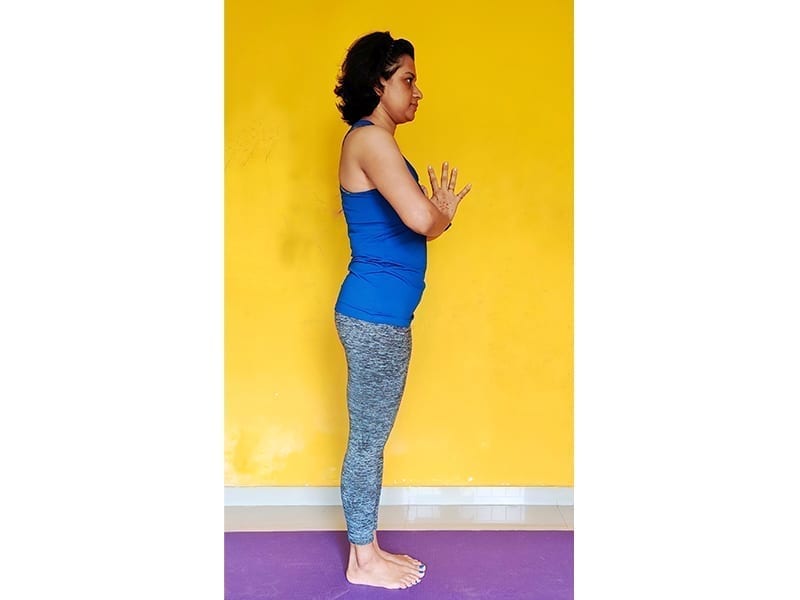
ॐ भास्कराय नमः Oṃ Bhāskarāya Namaḥ (giver of wisdom and cosmic illumination)
- As you exhale, bring your palms together in a prayer position in front of your chest.
- Relax in this position; observe the sensations in your body.
Consider adding Surya Namaskar in your daily yoga practice. Combine it with balanced nutrition for weight loss. Consult your doctor in case you have a medical condition before starting the 108 Surya Namaskar regime.

